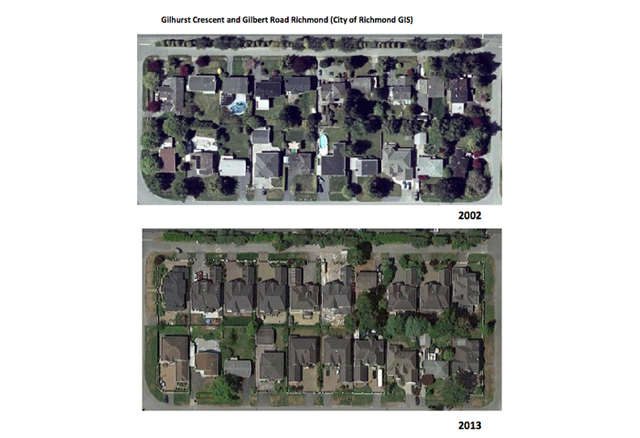The extent to which mega homes and new townhouse developments along arterial roads have impacted Richmond’s tree canopy is not known exactly, but Richmond resident John Terborg is willing to take a guess.
After comparing Google satellite images of Richmond from 2002 to 2013 and using an online program that calculates tree canopies, Terborg estimated that the Quilchena neighbourhood lost about 25 per cent of its mature trees as a result of new development.
He is hoping the City of Richmond factors in tree loss in an upcoming round of public consultation that will focus on bylaws surrounding how large and where a home’s footprint may be, including re-assessing side yard setbacks.
“The ‘Richmond special’ kind of development does not leave much room for green space. It’s very cookie cutter, wasteful and inefficient. There are definitely things that can be done,” said Terborg, who holds a masters in land and water systems.
Terborg sought help from former Richmond resident Lusha Zhou, a member of the Garden City Conservation Society, who is a master’s candidate in geography at the University of Toronto.
Zhou, who grew up in Richmond, said considering Richmond’s stated goals of being environmentally friendly, it makes sense to consider green space in new developments.
“Policies, regulations and practices should respect trees and green space,” said Zhou, noting trees are not protected from new mega home footprints in the city’s tree protection bylaws.
Furthermore, new homes tend to have large driveways and extra car garages.
“It is somewhat contradictory to the many goals of the city,” said Zhou, who specializes in satellite data analysis and green infrastructure.
Zhou and Terborg noted the preliminary analysis of Quilchena is not precise. Zhou is hoping to use better software and images, dating back decades.
Terborg hopes the city conducts a more sophisticated analysis of its tree canopy, much like Vancouver, which found its canopy had declined by about 20 per cent from 1995 to 2013.
“I know Richmond is facing similar pressures as Vancouver,” said Terborg.
Other cities, Terborg noted, that have been proactive with tree canopy studies have seen their canopies increase, most notably Toronto and Portland.
“In Richmond, we’re removing trees we probably don’t have to,” said Terborg.
Zhou, who now resides in Surrey, said her concern is that as the status quo remains the city will continue to lose trees and green space on private property.
According to Vancouver’s tree canopy study, the majority of trees and green space are found on private property.
Richmond has a tree protection bylaw and tree replacement policies but hundreds of trees are being replanted in public spaces, outside of residential neighbourhoods, each year.
The city also has many specific landscape design rules, such as what kinds of fences can be built and what shrubs can be planted for a new home. However, homeowners can still build driveways that cover the entire front yard.
Zhou and Terborg believe such policies need to be set with holistic thinking.
For example, Zhou said with more impermeable surfaces and less grass, there is more stress on the city’s drainage system.
Zhou said with fewer trees, which cool the ground, Richmond experiences more urban heat island effect, resulting in more air conditioning use.
And, “studies show green space is important for our mental health and child development, not to mention all the ecological benefits,” said Zhou.
The City of Vancouver, noting 23,490 healthy, mature trees were removed over the last two decades on private property, has stated its goal is to return its tree canopy to 1995 levels by 2055.
Its new policy of “plant the right tree in the right place” will attempt to balance the benefits of trees with competing interests.
* Tree benefits:
-Dust, smog and soot reduction
-Rainwater management
-Bird habitat
-Mental health benefits
-Shade and shelter
* Competing interests:
-Development
-Views and sunlight
-Allergies
-Maintenance
-Infrastructure conflicts (utility lines)
Source: City of Vancouver study (2014)



